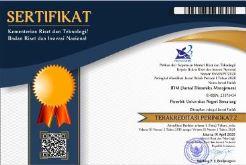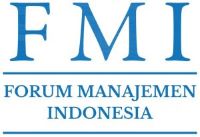Online Job Search Among Millennial Students in Malaysia
Abstract
Keywords
Full Text:
PDFReferences
Apel, R., Sweeten, G & Gary S. 2010. The Impact
of Incarceration on Employment during the
Transition to Adulthood. Social Problems. 57
(3): 448-79.
Autor, D. H. 2001. Wiring the Labor Market. Journal
of Economic Perspectives. 15 (1): 25-40.
Bort-Roig, J., Gilson, N. D., Puig-Ribera, A., Contreras,
R. S & Trost, S. G. 2014. Measuring and
influencing physical activity with smartphone
technology: A systematic review. Sports Medicine.
: 671-686.
Brosdahl, D. J. C & Carpenter, J. M, 2011. Shopping
orientations of US males: A generational
cohort comparison. Journal of Retailing and
Consumer Services. 18 (6): 548-554.
Chandran, V. 2013. Use and User Perception of
Electronic Information Resources: A Case
Study of Siva Institute of Frontier Technology,
India. Chinese Librarianship. (36): 85-98.
Chen, D. J. Q & Lim, V. K. G. 2012. Strength in adversity:
The influence of psychological capital
on job search. Journal of Organizational
Behavior. 33: 811-839.
Dammert, A. C., Galdo, J. C & Galdo, V. 2014.
Mobile phones for labor market intermediation:
A multi-treatment experimental design.
Working Paper.1-46.
Davis, F. 1989. Perceived usefulness, perceived ease
of use, and user acceptance of information
technology. MIS Quarterly. 13 (3): 319-340.
Davis, F. D., Bagozzi, R. P & Warshaw, P. R. 1992.
Extrinsic and intrinsic motivation to use
computers in the workplace. Journal of Applied
Social Psychology. 22 (14): 1111-1132.
Dong, T. P., Cheng, N. C & Wu, Y. C. J. 2014. A
study of the social networking website service
in digital content industries: The Facebook
case in Taiwan. Computers in Human
Behavior. 30: 708-714.
Eisinga, R., Grotenhuis, M. T & Pelzer, B. 2013. The
reliability of a two-item scale: Pearson, Cronbach,
or Spearman-Brown? International
Journal of Public Health. 58 (4): 637-642.
Hair, J. J. F., Black, W. C., Babin, B. J & Anderson, R.
E. (2010). Multivariate Data Analysis: A global
perspective (7th Ed.) Upper Saddle River,
NJ: Pearson Prentice Hall.
Hu, C.-P., Hu, Y & Yan, W.W. 2014. An empirical
study of factors influencing user perception
of university digital libraries in China. Library
& Information Science Research. 36 (3): 225-
Hudson, A. 2010. Measuring the impact of cultural
diversity on desired mobile reference services.
Reference Services Review. 38 (2): 299-308.
Immordino-Yang, M. H., Christodoulou, J. a &
Singh, V. 2012. Rest Is Not Idleness: Implications
of the Brain’s Default Mode for Human
Development and Education. Perspectives on
Psychological Science : A Journal of the Association
for Psychological Science. 7 (4): 352-64.
Jambulingam, M., Selvarajah, C. S & Thuraisingam,
A. S. 2014. Social Media Networks and Gen
Y. Journal of Applied Sciences, Engineering and
Technology. 8 (8): 1041-1044.
Kaplan, A. M & Haenlein, M. (2010). Users of the
world, unite! The challenges and opportunities
of Social Media. Business Horizons. 53
(1): 59-68.
Khoo, H. C. (2001). Graduating into the IT Industry.
Education Quarterly. 19: 14-15.
Kotler, P & Armstrong, G. 2001. Principles of Marketing.
Prentice-Hall, Englewood Cliffs, NJ.
Kuhn, P & Skuterud, M. 2004. Internet job search
and unemployment durations. American EcoJurnal
Dinamika Manajemen, 8 (1) 2017, 1-10
nomic Review. 94 (1): 218-232.
Lim, W. M & Ting, D. H. 2012. E-shopping: An
analysis of the technology acceptance model.
Modern Applied Science. 6 (4): 49-62.
Lin, H. F. 2010. Applicability of the extended theory
of planned behavior in predicting job seeker
intentions to use job-search websites. International
Journal of Selection and Assessment.
(1): 64-74.
Michelle, L. 2016. What You Didn’t Know About
Fresh Graduate Unemployment in Malaysia.
Available at: https://eduadvisor.my/articles/
what-didnt-know-fresh-graduate unemployment-
malaysia-infographic/. 18 March,
Suki, M. N., Ramayah, T., Kow Pei Ming, M & Suki,
N. M. 2011. Job searches via social networking
sites: Employed job seekers intentions.
Jurnal Pengurusan. 33: 77-86.
Malaysian Technical University Network. 2016. Available
at: https://mtun.uthm.edu.my/en/
uthm/fast-facts-uthm.html
Nigel Wright Recruitment. 2011. The impact of
social media on recruitment, Nigel Wright
Recruitment, Report 2011. Available at:
http://uk.nigelwright.com/NigelWright-
News/2011-02-01/New-report-uncoverstrue-
impact-of-social-media-on-recruitment/
Nikolaou, I. 2014. Social Networking Web Sites in
Job Search and Employee Recruitment. International
Journal of Selection and Assessment.
(2): 179-189.
Paulina, I & Wardoyo. (2012). Faktor Pendukung
Terhadap Intensi Berwirausaha Pada Mahasiswa.
Jurnal Dinamika Manajemen. 3 (1):
-10.
Park, J & Gursoy, D. 2012. Generation effects on
work engagement among U.S. hotel employees.
International Journal of Hospitality Management,
(4): 1195-1202.
Romli, A., Ghozali, M., Mohtar, S & Ramli, A. 2012.
UUM Student Perception on the Use of Job
Search Website in Malaysia: 978-979.
Saundres, M., Lewis, P & Thronhill, A. 2012. Research
Methods for Business Student. Fixth Edition
London: Prentice Hall.
Shaffiei, Z. A., Mokhsin, M., Hamidi, S. R., & Yusof,
N. M. 2011. A study of user’s acceptance
and perception towards Campus Management
System (CMS) using Technology Acceptance
Model (TAM). In 2011 3rd International
Congress on Engineering Education:
Rethinking Engineering Education, The Way
Forward (ICEED):128-131.
Shockley, P. R. 2007. Thomas Reid’s Theory of Perception
Presented to Dr . Mike LeBuffe Professor
of Philosophy Texas A & M University. In
Partial Fulfillment if the Requirements for
the Course Modern Philosophy Fall 2007 By
Paul R. Shockley 303 Dukes Bend Stafford,
Texas T. 1-28.
Sills, M. 2014. E-recruitment. A comparison with traditional
recruitment ant the influences of social
media. Available at: https://www.theseus.
fi/bitstream/handle/10024/80428/Sills_
Maureen.pdf?sequence=1. 30 September
Suvankulov, F. 2010. Job Search on the Internet, ERecruitment,
and Labor Market Outcomes.
RAND.
Teoh, W. M., Tan, S & Chong, S. C. 2013. Factors
Influencing Perceptions of University.18
(1): 123-142.
Ting, D. H., Lim, S. F., Patanmacia, T. S., Low, C.
G & Ker, G. C. 2011. Dependency on smartphone
and the impact on purchase behaviour.
Young Consumers: Insight and Ideas for
Responsible Marketers. 12 (3): 193-203.
Visher, C & Kachnowski, V 2007. Finding Work
on the Outside: Results from the Returning
Home’ Project in Chicago in Barriers to Reentry?
The Labor Market for Released Prisoners
in Post-industrial America, edited by Shawn
Bushway, Michael A Stoll, and David Weiman.
New York: Russell Sage Foundation.
Wankel, C & Stachowicz-Stanusch, A. 2011. Management
Education for Integrity: Ethically Educating
Tomorrow’s Business Leaders. Emerald
View Counter: Abstract - 2379 and PDF - 1711
Refbacks
- There are currently no refbacks.





